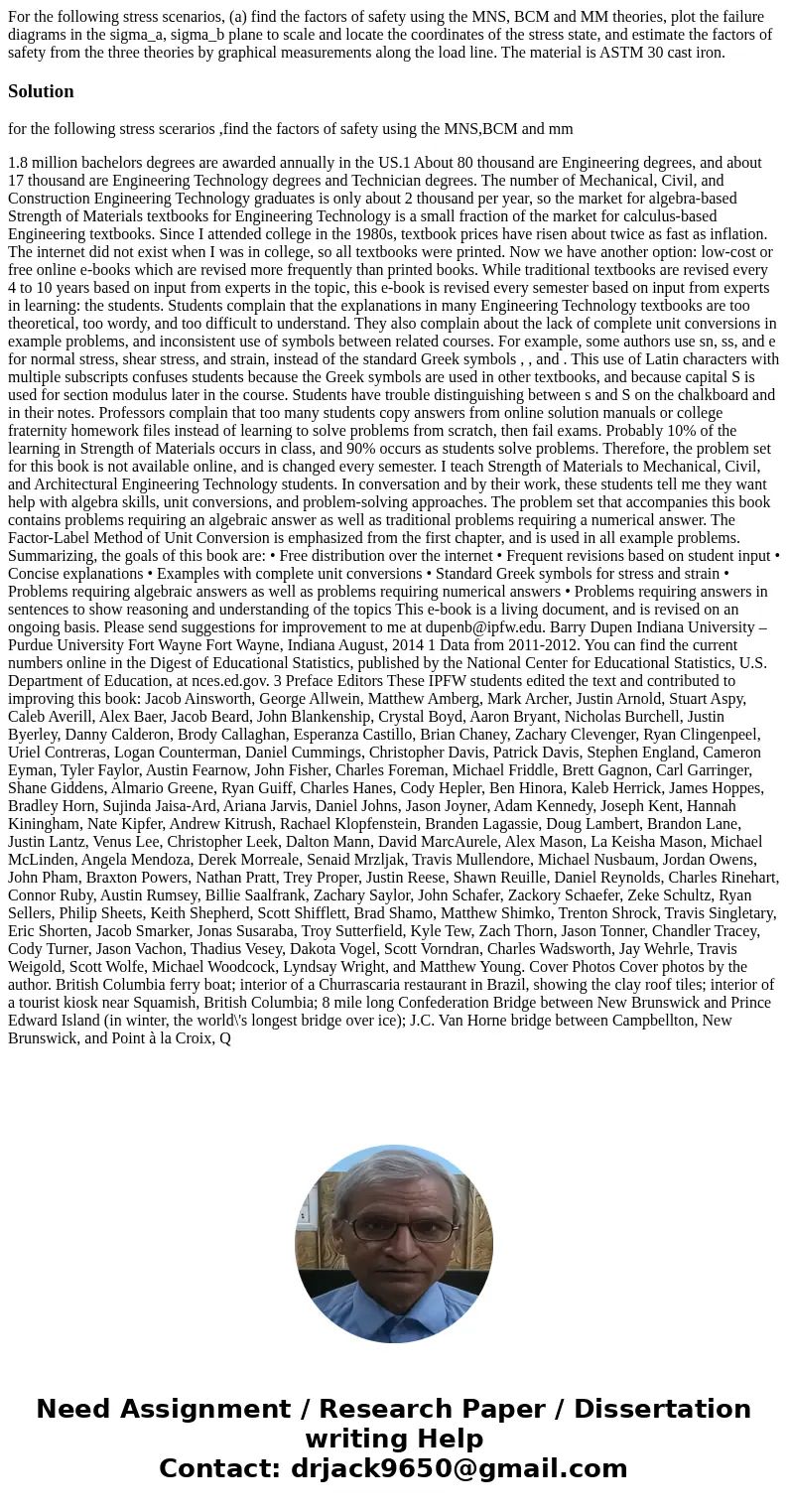For the following stress scenarios a find the factors of saf
Solution
for the following stress scerarios ,find the factors of safety using the MNS,BCM and mm
1.8 million bachelors degrees are awarded annually in the US.1 About 80 thousand are Engineering degrees, and about 17 thousand are Engineering Technology degrees and Technician degrees. The number of Mechanical, Civil, and Construction Engineering Technology graduates is only about 2 thousand per year, so the market for algebra-based Strength of Materials textbooks for Engineering Technology is a small fraction of the market for calculus-based Engineering textbooks. Since I attended college in the 1980s, textbook prices have risen about twice as fast as inflation. The internet did not exist when I was in college, so all textbooks were printed. Now we have another option: low-cost or free online e-books which are revised more frequently than printed books. While traditional textbooks are revised every 4 to 10 years based on input from experts in the topic, this e-book is revised every semester based on input from experts in learning: the students. Students complain that the explanations in many Engineering Technology textbooks are too theoretical, too wordy, and too difficult to understand. They also complain about the lack of complete unit conversions in example problems, and inconsistent use of symbols between related courses. For example, some authors use sn, ss, and e for normal stress, shear stress, and strain, instead of the standard Greek symbols , , and . This use of Latin characters with multiple subscripts confuses students because the Greek symbols are used in other textbooks, and because capital S is used for section modulus later in the course. Students have trouble distinguishing between s and S on the chalkboard and in their notes. Professors complain that too many students copy answers from online solution manuals or college fraternity homework files instead of learning to solve problems from scratch, then fail exams. Probably 10% of the learning in Strength of Materials occurs in class, and 90% occurs as students solve problems. Therefore, the problem set for this book is not available online, and is changed every semester. I teach Strength of Materials to Mechanical, Civil, and Architectural Engineering Technology students. In conversation and by their work, these students tell me they want help with algebra skills, unit conversions, and problem-solving approaches. The problem set that accompanies this book contains problems requiring an algebraic answer as well as traditional problems requiring a numerical answer. The Factor-Label Method of Unit Conversion is emphasized from the first chapter, and is used in all example problems. Summarizing, the goals of this book are: • Free distribution over the internet • Frequent revisions based on student input • Concise explanations • Examples with complete unit conversions • Standard Greek symbols for stress and strain • Problems requiring algebraic answers as well as problems requiring numerical answers • Problems requiring answers in sentences to show reasoning and understanding of the topics This e-book is a living document, and is revised on an ongoing basis. Please send suggestions for improvement to me at dupenb@ipfw.edu. Barry Dupen Indiana University – Purdue University Fort Wayne Fort Wayne, Indiana August, 2014 1 Data from 2011-2012. You can find the current numbers online in the Digest of Educational Statistics, published by the National Center for Educational Statistics, U.S. Department of Education, at nces.ed.gov. 3 Preface Editors These IPFW students edited the text and contributed to improving this book: Jacob Ainsworth, George Allwein, Matthew Amberg, Mark Archer, Justin Arnold, Stuart Aspy, Caleb Averill, Alex Baer, Jacob Beard, John Blankenship, Crystal Boyd, Aaron Bryant, Nicholas Burchell, Justin Byerley, Danny Calderon, Brody Callaghan, Esperanza Castillo, Brian Chaney, Zachary Clevenger, Ryan Clingenpeel, Uriel Contreras, Logan Counterman, Daniel Cummings, Christopher Davis, Patrick Davis, Stephen England, Cameron Eyman, Tyler Faylor, Austin Fearnow, John Fisher, Charles Foreman, Michael Friddle, Brett Gagnon, Carl Garringer, Shane Giddens, Almario Greene, Ryan Guiff, Charles Hanes, Cody Hepler, Ben Hinora, Kaleb Herrick, James Hoppes, Bradley Horn, Sujinda Jaisa-Ard, Ariana Jarvis, Daniel Johns, Jason Joyner, Adam Kennedy, Joseph Kent, Hannah Kiningham, Nate Kipfer, Andrew Kitrush, Rachael Klopfenstein, Branden Lagassie, Doug Lambert, Brandon Lane, Justin Lantz, Venus Lee, Christopher Leek, Dalton Mann, David MarcAurele, Alex Mason, La Keisha Mason, Michael McLinden, Angela Mendoza, Derek Morreale, Senaid Mrzljak, Travis Mullendore, Michael Nusbaum, Jordan Owens, John Pham, Braxton Powers, Nathan Pratt, Trey Proper, Justin Reese, Shawn Reuille, Daniel Reynolds, Charles Rinehart, Connor Ruby, Austin Rumsey, Billie Saalfrank, Zachary Saylor, John Schafer, Zackory Schaefer, Zeke Schultz, Ryan Sellers, Philip Sheets, Keith Shepherd, Scott Shifflett, Brad Shamo, Matthew Shimko, Trenton Shrock, Travis Singletary, Eric Shorten, Jacob Smarker, Jonas Susaraba, Troy Sutterfield, Kyle Tew, Zach Thorn, Jason Tonner, Chandler Tracey, Cody Turner, Jason Vachon, Thadius Vesey, Dakota Vogel, Scott Vorndran, Charles Wadsworth, Jay Wehrle, Travis Weigold, Scott Wolfe, Michael Woodcock, Lyndsay Wright, and Matthew Young. Cover Photos Cover photos by the author. British Columbia ferry boat; interior of a Churrascaria restaurant in Brazil, showing the clay roof tiles; interior of a tourist kiosk near Squamish, British Columbia; 8 mile long Confederation Bridge between New Brunswick and Prince Edward Island (in winter, the world\'s longest bridge over ice); J.C. Van Horne bridge between Campbellton, New Brunswick, and Point à la Croix, Q

 Homework Sourse
Homework Sourse